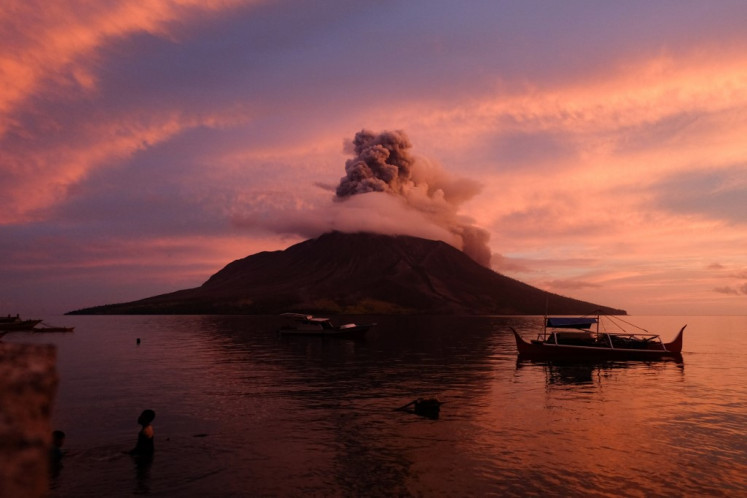Women advance in art, if not life
Arahmaiani’s Hot Date, acrylic on canvas (JP/Carla Bianpoen) The exhibition of 10 women artists at Salihara commemorates two complementary events that turn the spotlight on the position of women in today’s society: International Women’s Day and Indonesia’s Kartini Day
Change Size

Arahmaiani’s Hot Date, acrylic on canvas (JP/Carla Bianpoen)
The exhibition of 10 women artists at Salihara commemorates two complementary events that turn the spotlight on the position of women in today’s society: International Women’s Day and Indonesia’s Kartini Day.
International Women’s Day emerged from the oppression and inequality of women in the industrialized world of the early 1900s, which led 15,000 women to join a 1908 march through New York City, demanding shorter hours, better pay and voting rights. But it was Clara Zetkin, leader of the working women’s Office for the Social Democratic Party in Germany, who proposed
the idea of International Women’s Day at the Second International Conference of Working Women in 1910. International Women’s Day has since grown to become a global day of recognition and celebration across developed and developing countries alike.
In the case of Kartini Day, it was Indonesia’s first president who, in 1964, gave R.A. Kartini national recognition as a hero and declared her date of birth, April 21, a national holiday. R.A. Kartini, who lived from April 21, 1879, to Sept. 17, 1904, strived for equal rights for women – education for girls, abolition of polygamy – but also for religious tolerance and plurality as part of a greater scheme for her people’s independence. Although she is a national hero, she is generally hailed as a pioneer for women’s rights.
To commemorate and celebrate these two events, Salihara Art Gallery organized an exhibition of works by 10 contemporary women artists. It is an important display of how women artists – who have mostly been ignored in the past – are now taking their place in the sun. Arahmaiani, Astari, Ay Tjoe Christine, Dolorosa Sinaga, Titarubi, Wara Anindyah and Yani Mariani have established a name in the art world, while Ayu Arista Murti and Theresia Agustina Sitompul are two emerging hopefuls.
The works testify to the variety of mediums and the concerns of women, which include issues of cultural heritage and political critique, but also the stresses of a housewife and the fate of battered women.
Those who have followed the course of Indonesia’s women artists will note several changes in the works of some artists. Sadly, however, the works in this exhibition, while showing the advance of these women artists in their use of various mediums and techniques, fail to reflect any progress in the situation of women in general. Theresia, using fluorescent phosphor resin in her 3-D sculpture, represents the hard-working mother who needs multiple hands and arms; Dolorosa Sinaga, Indonesia’s most senior female sculptor, using a new technique for her sculptures, shows an unhappy family with the woman having appearing battered, now being reproached by the man, leaving their child in helpless confusion; and both Wara Anindya and Ayu Arista Murti feature anxiety in their near horror images. Given reports on domestic violence and the hard times endured by women in certain situations, such representations in art should not be surprising.
But artists such as Arahmaiani (Iani) and Astari appear to have passed beyond the line of such hardship. Iani, who is best known internationally for her performance art criticizing existing discrimination against the marginalized and powerless masses, continues to speak out for the less favored, but, returning to painting, she now uses the icons of Disney cartoons to comment on American oil politics. Free Fall and Hot Date at first sight give the impression of a Mickey Mouse cartoon, but underlying the vibrant colors and amusing comics is a sharp critique.

Astari’s works are, as usual, finely finished and sprout from creative thought and vision. Her works in this exhibition engage in the issue of balancing an appreciation of one’s rich cultural heritage with a modern lifestyle influenced by a global culture. Her painting titled Lisoy shows the burden of the modern Batak woman in a semicomical and humorous manner. It features a Batak woman balancing on her head a rolled-up Batak cloth (her traditional culture) and an expensive brand-name bag holding a bottle of champagne (globalized modern lifestyle). In the same vein, her bronze brand-name bag with the Read inscription shows the balancing of life and lifestyle in the juxtaposition of The Wall Street Journal with the Koran.
The issue of “the other” has engaged Mella Jaarsma throughout her artistic career with the burqa appearing in many variations to comment on issues of race, minority and identity. In this exhibition she has transformed the burqa into flags, Your Flag and My Flag; the issues are the same.
Meanwhile, Ay Tjoe Christine’s refined drawings encourage us to be happy with whatever we have. Menghadap Kiri 1 and 2 say “when you look left, just see what is on the left, don’t bother with anything else,” explains the artist. Titarubi, who has been known for her sculptures and installations, here shows her might in a powerful charcoal drawing Shadow on Shadow, in which the layering may be understood as the shades of meaning in life. Yani Mariani, who is known for her large public sculptures that always have a feminine touch however large they may be, brings two relatively small sculptures reflecting life experience in Limit and her love of myths and legends in Dewa Tara, a Buddhist deity who is transformed into a goddess.
The exhibition comes with an exceptional catalogue, in which each of the 10 artists has been “reviewed” by a separate female writer. It is as if, through this exhibition, we were called on to recognize Indonesia’s foremost pioneer of women’s rights, R.A. Kartini, who, during her short life left us not only her prolific and proficient writings, but also a few paintings, two of which were sent to the Dutch queen as a gift.
10 Perupa PerempuanAn exhibition of 10 women artists
Until April 17, 2009
At Salihara Gallery
Jl Salihara 15-16, Pasar Minggu
Tel: 021-7812036, 021-7812037









